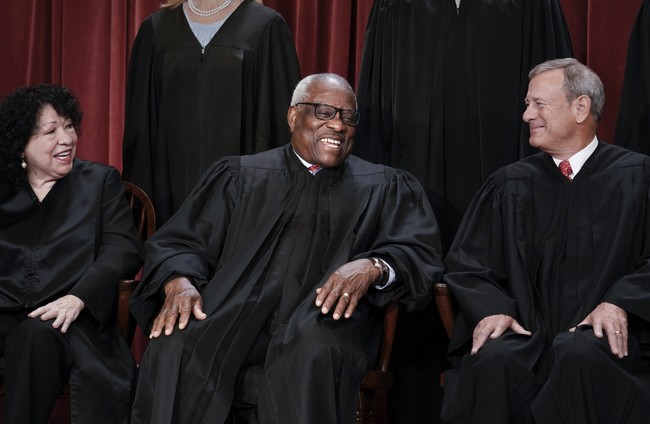Hmmm: SCOTUS Agrees to Hear Challenge on Birthright Citizenship
This post was originally published on this site

Curious indeed. The Trump administration had petitioned the Supreme Court for stays in three different challenges on Donald Trump’s executive order on birthright citizenship. The easiest action to take would have been to ignore the requests and let the cases play out, likely well into the next Supreme Court term.
Advertisement
Instead, the court decided to consolidate the cases and grant cert on the merits:
Consideration of the application (24A884) for partial stay presented to The Chief Justice and by him referred to the Court is deferred pending oral argument. Consideration of the application (24A885) for partial stay presented to Justice Kagan and by her referred to the Court is deferred pending oral argument. Consideration of the application (24A886) for partial stay presented to Justice Jackson and by her referred to the Court is deferred pending oral argument. The applications are consolidated, and a total of one hour is allotted for oral argument. The applications are set for oral argument at 10 a.m. on Thursday, May 15, 2025.
The New York Times also finds this a little surprising:
The brief order by the justices was unsigned and gave no reasoning, as is typical in such emergency cases. But the move is a sign that the justices consider the matter significant enough that they would immediately consider it, rather than letting it play out in lower courts.
The justices announced they would defer any consideration of the government’s request to lift a nationwide pause on the policy until they heard oral arguments, which they set for May 15.
That means that the executive order, which would end birthright citizenship for the children of undocumented immigrants and foreign residents, will remain paused in every state while the court considers the case.
Advertisement
True, but as the next paragraph explains, that was also the status after the lower-court rulings. The Supreme Court could have left it alone to achieve that outcome by default:
In three emergency applications, the Trump administration asked the Supreme Court to find that lower courts had erred in imposing bans on the policy that extended beyond the parties involved in the litigation. It did not ask the court to weigh in on the constitutionality of the executive order, which was challenged soon after it was signed.
What does this mean? It means that at least four of the justices want to debate this case now, rather than later. But are they debating the merits of the order, or the reach of the stays?
Today’s cert and consolidation doesn’t offer any direct clues, as usual. Occasionally, the court will issue an order defining the scope of its review, but this order contains no such limitation. It appears that the Trump administration wants to challenge district courts in their habit these days of applying stays and injunctions nationally or at least more broadly than the parties involved in these disputes. But that doesn’t mean that the Supreme Court has to limit itself to those issues; they have plenary jurisdiction over cases in the federal judiciary and can decide to hear all issues at hand if four or more justices desire. (It takes four justices to approve the writ of certiorari necessary to hear an appeal.)
Advertisement
ABC News reports that this was the argument that the Trump administration put before the court:
“This Court should declare that enough is enough before district courts’ burgeoning reliance on universal injunctions becomes further entrenched,” Trump’s acting solicitor general wrote in the application. “The Court should stay the district courts’ preliminary injunctions except as to the individual plaintiffs and the identified members of the organizational plaintiffs (and, if the Court concludes that States are proper litigants, as to individuals who are born or reside in those States).”
“At a minimum, the Court should stay the injunctions to the extent they prohibit agencies from developing and issuing public guidance regarding the implementation of the Order. Only this Court’s intervention can prevent universal injunctions from becoming universally acceptable,” she added.
However, ABC also points out the same lack of limitation in this order, and what that could mean:
While the immediate issue is the scope of the injunctions, it’s also possible the justices wade into the substance of Trump’s executive order itself and the constitutionality of birthright citizenship, which was enshrined in the 14th Amendment and been repeatedly upheld by high court precedent.
Advertisement
One point to bear in mind: the court has had ample opportunities to address jurisdictional limits in other recent challenges. They rebuked Judge James Boasberg for proceeding in an improper venue, and that did seem to have an impact on two other courts hearing challenges in the separate issue of the use of the Alien Enemies Act for accelerated deportations. Those other cases seem better for a more direct declaration of jurisdictional limitations, but perhaps this is just the first case (or set of cases, more accurately) to annoy enough justices to warrant a long-needed intervention to discourage venue-shopping.
Plus, if that were the limit of the court’s interest, they could have resolved it without resorting to consolidation or a cert for a full hearing. The court could have just issued the stay that the Trump administration requested and ordered the lower courts to remove any application outside their jurisdictions and to entities that are not parties to these disputes. That would have been relatively simple — and a little more in character for a court that rarely sticks its neck out when other options are available.
We’ll know more sooner than later, but this appears to be a recognition that only the Supreme Court can effectively resolve the debate over the language and meaning of the citizenship clause in the 14th Amendment. Furthermore, it at least hints that four justices may believe that the common understanding needs correction, and that Wong Kim Ark either got it wrong or has been misinterpreted in the 127 years since the decision. At the very least, there seem to be enough justices who want to hear arguments to rip off this particular legal Band-Aid now rather than watch it careen around the federal judiciary for the next couple of years.
Advertisement
Curious indeed. Stay tuned.
